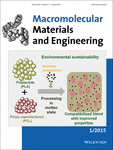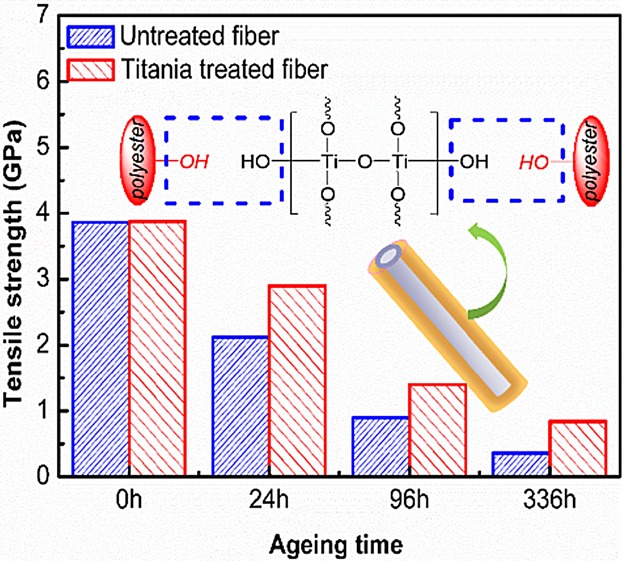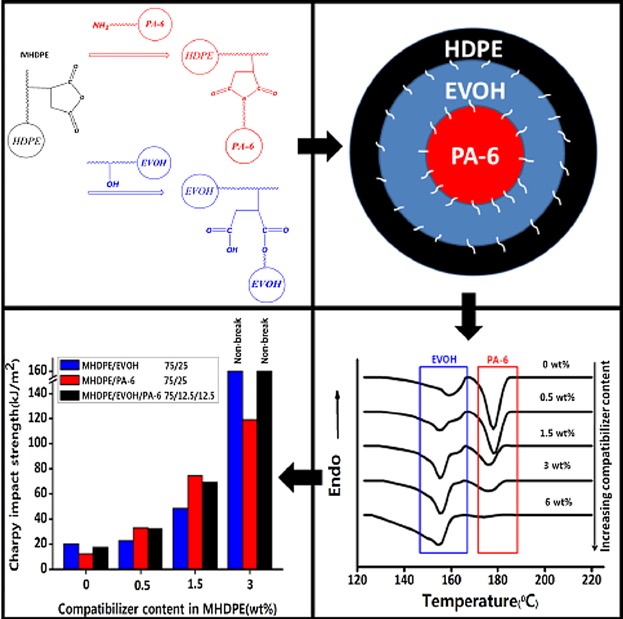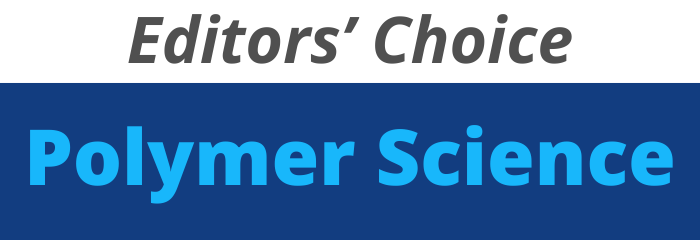Journal list menu
Export Citations
Download PDFs
Cover Picture
Cover Picture: Macromol. Mater. Eng. 1/2015
- Page: 1
- First Published: 05 January 2015
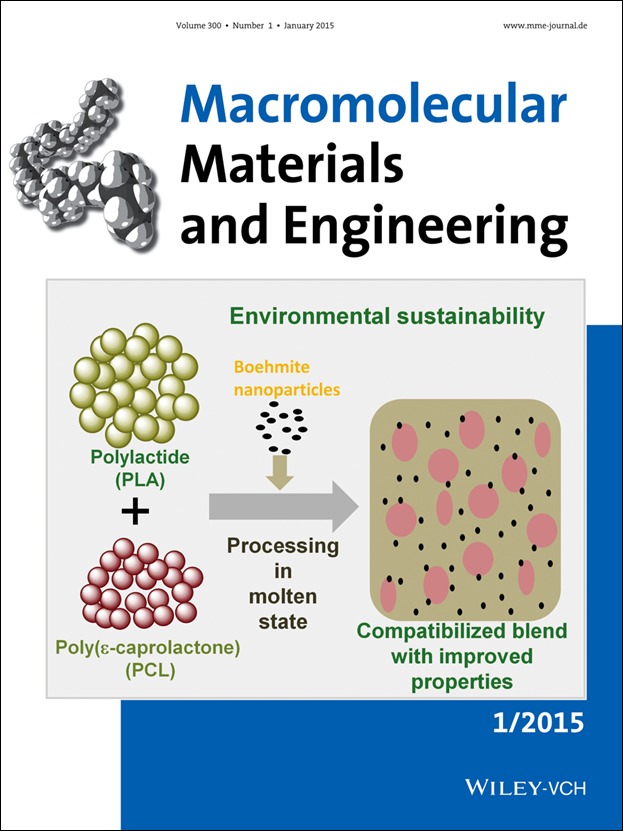
Front Cover: Polylactide (PLA) is a bio-based biodegradable thermoplastic polyester. PLA shows good strength and stiffness, optical and physical properties, and is expected to be a sustainable alternative to traditional petroleum-based plastics. However, its low toughness, impact and melt strength, and thermal stability during processing limit its wide range of applications. Here, PLA is melt-blended with highly ductile, biodegradable poly(ϵ-caprolactone) (PCL) in the presence of boehmite (BAI) nanoparticles to mitigate the disadvantages of PLA. Further details can be found in the article by S. C. Agwuncha, S. S. Ray,* J. Jayaramudu, C. Khoathane, and R. Sadiku on page 31.
Back Cover
Back Cover: Macromol. Mater. Eng. 1/2015
- Page: 128
- First Published: 05 January 2015
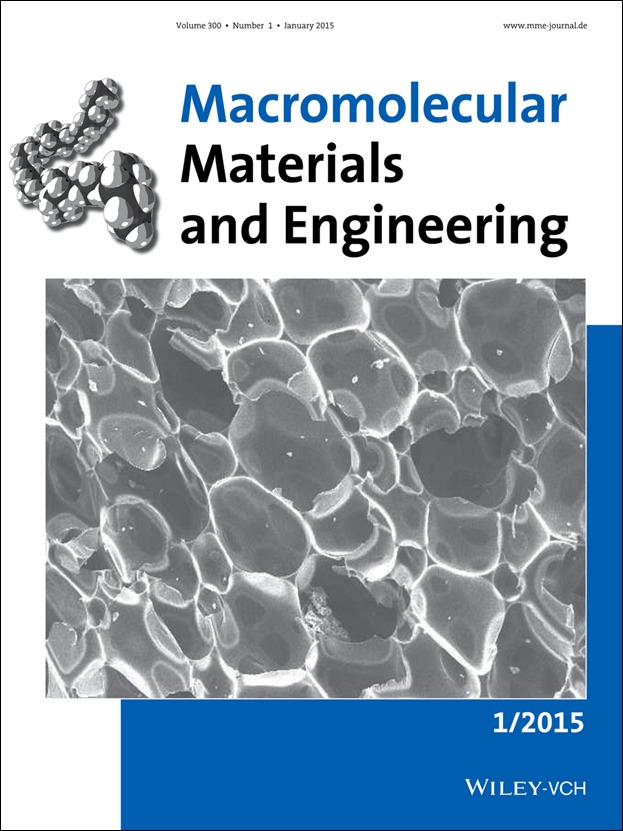
Back Cover: Highly expanded open-cell polycarbonate foams are developed using an injection molding process. The foams are characterized in terms of their mechanical properties as well as for sound and thermal insulations. The test results show that the newly developed foams improve sound and thermal insulations up to 2.5 and 5 times, respectively. Further details can be found in the article by D. Jahani, A. Ameli, M. Saniei, W. Ding, C. B. Park,* and H. E. Naguib on page 48.
Masthead
Contents
Editorial
New Editorial Structure for the Macromolecular Journals
- Pages: 8-9
- First Published: 05 January 2015
Review
A Review: Natural Fiber Composites Selection in View of Mechanical, Light Weight, and Economic Properties
- Pages: 10-24
- First Published: 02 September 2014
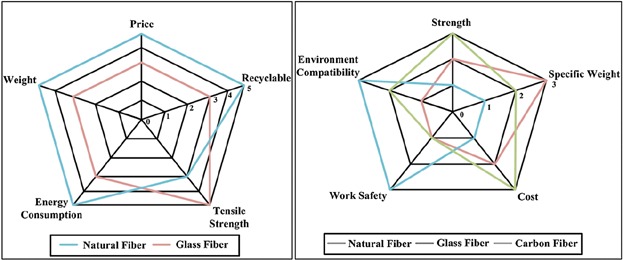
Due to light weight, low cost, and reasonable strength, natural fiber are replacing synthetic fibers and because of these properties their applications in automobile industries were increased. Comparisons of material indices are made to investigate the possibility to use natural fiber composites instead of some conventional and non-conventional materials for beam and panel structures.
Communication
Altering the Trigger-Behavior of Programmed Shape Memory Natural Rubber (SMNR) by Solvent Vapor
- Pages: 25-30
- First Published: 12 September 2014

The trigger-behavior of a programmed SMNR is significantly changed by treating the constrained sample with solvent vapor. This solvent-induced athermal alteration of the trigger-temperature is a new way to change the properties of a shape memory polymer after programming. The here introduced evaluation method of the trigger-curve by the first derivative allows clearer insights in the trigger-behavior.
Full Papers
Influence of Boehmite Nanoparticle Loading on the Mechanical, Thermal, and Rheological Properties of Biodegradable Polylactide/Poly(ϵ-caprolactone) Blends
- Pages: 31-47
- First Published: 07 November 2014
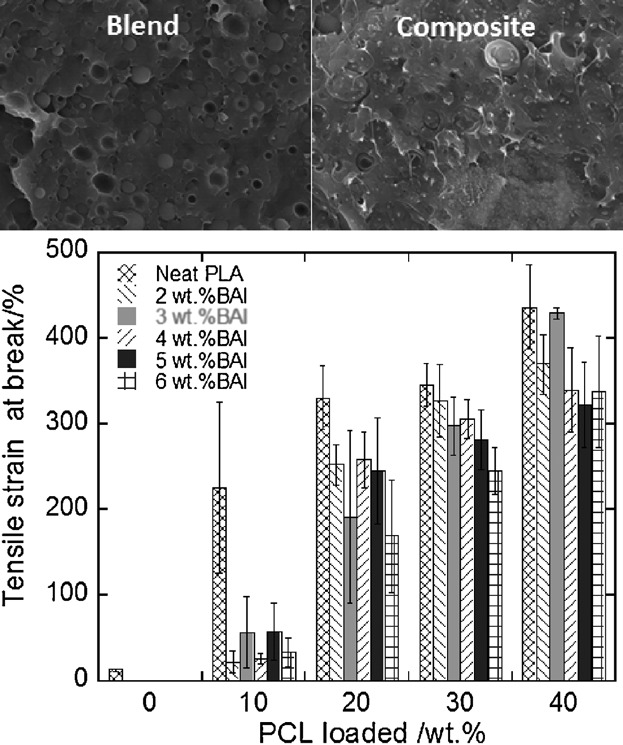
To broaden the biodegradable PLA possible applications, blends of PLA/PCL are processed with boehmite (BAI) nanoparticles. The resulting ternary composites are characterized for their thermal, mechanical, and rheological properties. Results show that the addition of BAI nanoparticles leads to reasonable improvement in the phase separated morphology of PLA/PCL blends and that a maximum BAI loading of 4 wt% is required for balanced properties.
Characterization of the Structure, Acoustic Property, Thermal Conductivity, and Mechanical Property of Highly Expanded Open-Cell Polycarbonate Foams
- Pages: 48-56
- First Published: 18 August 2014
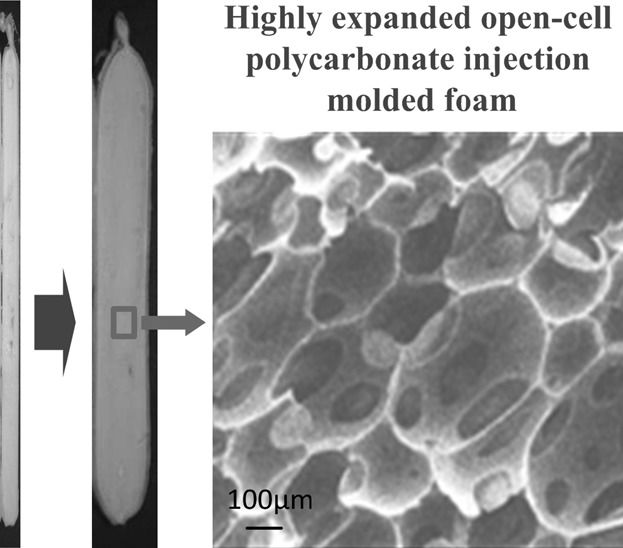
Highly expanded open-cell polycarbonate foams are developed using an injection molding process. Thinning of the cell walls and high shear rates result in pin holes on the cell walls. Foams are characterized for sound and thermal insulations and mechanical properties. The test results show that the developed foams improve the sound and thermal insulations up to 2.5 and 5 times, respectively.
Thermo-Moldable Nanocomposite Hydrogels
- Pages: 57-63
- First Published: 18 August 2014

Polymer-hectorite clay nanocomposite hydrogels (NC gels) can be thermo-molded to desired shapes at 80 °C and the shape can be fixed by cooling down to 20 °C, similar to thermoplastic polymers, due to their reversible crosslinks. This thermo-moldable property provides a facile method to deform or pattern NC gels on demand, which is significant for biomedical applications.
Hyperbranched Polyester-Stabilized Nanotitania-Coated Vectran Fibers with Improved UV-Blocking Performance
- Pages: 64-69
- First Published: 18 August 2014
Epoxy/Poly(ethylene-co-methacrylic acid) Blends as Thermally Activated Healing Agents in an Epoxy/Amine Network
- Pages: 70-79
- First Published: 18 August 2014

Thermally activated healing of a cured epoxy/amine network using blends of thermoplastic poly(ethylene-co-methacrylic acid) (EMAA) healing agent with solid epoxy resins to incorporate covalent and non-covalent bonding during healing is presented. Compatibility, preferential miscibility, and chemical interactions between the EMAA and epoxy resin modifier are found to be the critical factors in determining healing for a reactive epoxy/amine network.
Transparent Silicone Calcium Fluoride Nanocomposite with Improved Thermal Conductivity
- Pages: 80-85
- First Published: 18 August 2014
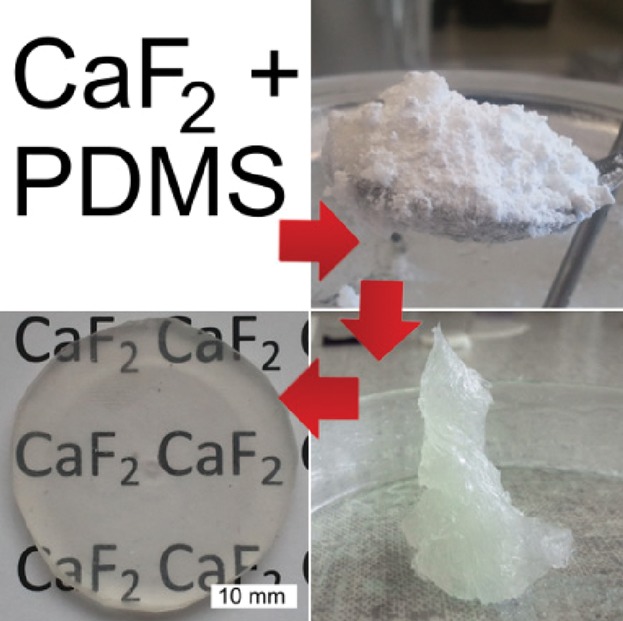
High thermal conductive materials are required for the construction and packaging of electronic devices. The thermal conductivity of polymeric materials can be improved when employing (nano-)composites–but these materials are opaque. This paper reports on a composite material that combines high transparency (by refractive index matching of the components) and improved thermal conductivity.
Reactive Compatibilization of Ternary Polymer Blends with Core–Shell Type Morphology
- Pages: 86-98
- First Published: 18 August 2014
Characterization of Viscoelasticity and Self-Healing Ability of VHB 4910
- Pages: 99-106
- First Published: 18 August 2014
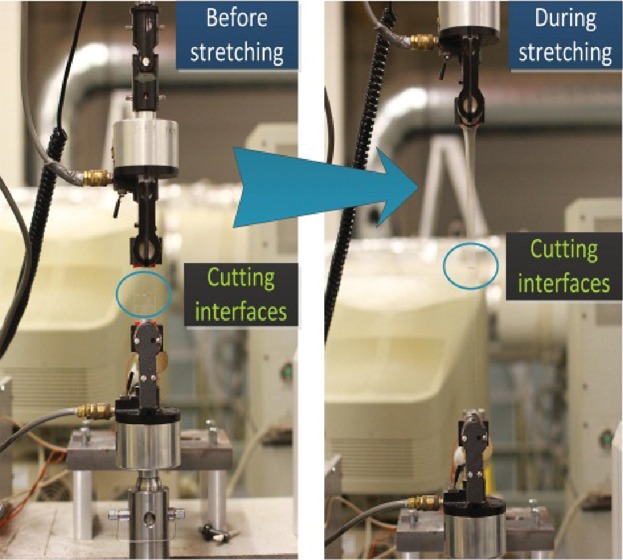
Self-healing materials are a hot topic at present; however, the lack of strength limits the application of such materials. VHB 4910 is heavily studied for the application as dielectric actuator due to its electro-activity. The self-recovery and self-healing mechanism and ability are studied in this paper. This study is believed to stimulate more research and application on this material.
Remineralization of Demineralized Dentin Induced by Amine-Terminated PAMAM Dendrimer
- Pages: 107-117
- First Published: 18 August 2014
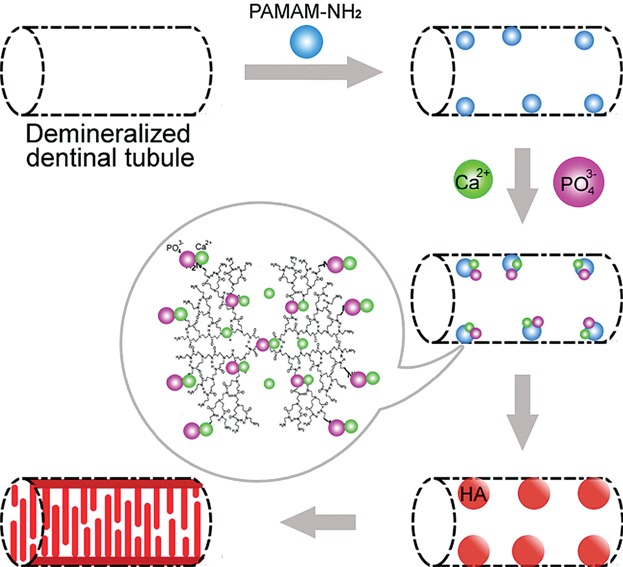
Amine-terminated PAMAM (PAMAM-NH2) dendrimer, has been often referred to as “artificial protein.” It can modulate the biomineralization process and lead to remineralization due to its reactive shell. In this work, G3-PAMAM-NH2 successfully induces needle-like minerals to precipitate on the dentin surface and within the dentinal tubules. G3-PAMAM-NH2 has great potential to be applied in clinical treatment in the future.
Melt Processing and Characterization of Bionanocomposites Made from Poly(butylene succinate) Bioplastic and Carbon Black
- Pages: 118-126
- First Published: 26 August 2014
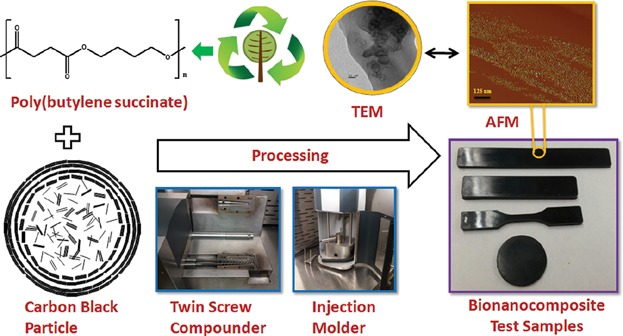
Now that biopolymers have entered the industrial marketplace, new advancements in biobased nanocomposites are underway. Using poly(butylene succinate) (PBS) and low volume percentages of carbon black filler, a thermal and electrically conductive plastic with good particle dispersion and increased mechanical performance may be obtained compared to conventional PBS.




